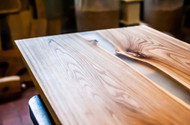Epoxy countertops have rapidly gained popularity for their stunning appearance and remarkable durability. However, the intricate chemistry and engineering involved in crafting these exquisite surfaces might go unnoticed by many. In this article, we will delve into the captivating science behind epoxy countertops, emphasizing how they combine aesthetics with resilience and longevity.
The Epoxy Resin
The core component epoxy resin itself lies at the heart of every epoxy countertop. Epoxy resin is an artificial polymer generated by chemically fusing epoxide compounds with hardening agents, generally amines or polyamines. This intricate chemical reaction, referred to as curing or polymerization, is the foundation of the epoxy's strength and resilience.
Cross-Linking for Strength
In the curing process, epoxy molecules establish robust covalent bonds among themselves, giving rise to an intricate three-dimensional framework of interlinked chains. This network, called cross-linking, is the key element to epoxy's incredible strength and resistance. The resulting material is highly constant and resistant to wear, making it ideal for countertops.
Aggregates and Fillers
Epoxy countertops frequently incorporate aggregates and fillers into the epoxy resin to enhance their overall visual appearance and durability. These materials are an integral part of the engineering behind epoxy countertops.
Aesthetic Aggregates
Decorative aggregates like quartz crystals, colored glass, metallic powders, or natural stones are assorted to epoxy countertops to create intricate patterns and stunning visual effects. These aggregates are carefully selected for their size, shape, and color, allowing designers to achieve specific aesthetics.
Reinforcing Fillers
To strengthen the epoxy, fillers like microspheres or silica are assorted into the resin. These fillers help to prevent cracking and expand impact resistance. By adding the right combination of fillers, epoxy countertops can endure heavy use without compromising their appearance.
The Role of Catalysts
Catalysts play a central role in epoxy countertop chemistry. They initiate and accelerate the curing process, guaranteeing that the epoxy reinforces homogeneously. The selection of catalyst can impact the curing time and the final properties of the epoxy, containing its hardness and heat resistance.
Heat Resistance
The noteworthy heat resistance of epoxy countertops originates from the epoxy resin's capacity to endure elevated temperatures without warping or discoloration. This particular attribute proves crucial, especially in environments like kitchens, where countertops often encounter the placement of hot pots and pans.
Chemical Resistance
Another significant feature of epoxy countertops is their capacity to withstand chemical substances. Epoxy's cross-linked structure forms a protective barrier that shields it from the corrosive effects of acids, bases, and other chemicals. This quality renders epoxy countertops well-suited for positioning in environments such as laboratories, medical establishments, and industrial setups where interaction with chemicals is prevalent.
Longevity and Durability
The distinctive amalgamation of cross-linking, fillers, aggregates, and curing techniques collectively enhances the enduring strength and robustness of epoxy countertops. With adequate maintenance, these surfaces can remain resilient for decades, making them a wise investment for both homeowners and businesses.
Conclusion
Benefits of Epoxy Countertops
- Unmatched Durability: Epoxy countertops are incredibly strong due to the cross-linking of epoxy molecules. This process creates a three-dimensional framework that makes the surface resistant to wear, impact, and damage.
- Heat Resistance: Epoxy's ability to withstand high temperatures makes it ideal for kitchens. It can endure the heat from hot pots and pans without warping or discoloration.
- Chemical Resistance: The cross-linked structure of epoxy provides a protective barrier against corrosive chemicals, making it suitable for environments like labs, medical facilities, and industrial settings.
- Aesthetic Versatility: Epoxy countertops can be customized with decorative aggregates like quartz, colored glass, or metallic powders, allowing for stunning visual designs and intricate patterns.
- Longevity: Thanks to its durable composition, epoxy countertops can last for decades with proper care, offering long-term value for both residential and commercial use.
- Crack Prevention: Reinforcing fillers such as microspheres or silica are added to prevent cracking and increase impact resistance, ensuring the countertop remains intact under heavy use.
- Low Maintenance: Epoxy surfaces are easy to clean and maintain, as their non-porous nature prevents the absorption of liquids and stains, keeping them hygienic and attractive.
- Smooth Finish: Epoxy countertops are known for their glossy, seamless appearance, which improves the overall aesthetic of kitchens, bathrooms, and commercial spaces.
Customizable: The use of various catalysts and fillers allows manufacturers to fine-tune the curing process, resulting in countertops with specific hardness, heat tolerance, and durability.Epoxy countertops are a testimony to the power of science and engineering in the world of interior design. Their beauty, resilience, and longevity are the consequence of careful chemistry and material choice. From the cross-linking of epoxy molecules to the addition of aggregates and fillers, every component contributes to their outstanding performance.
It entails choosing a surface that has been thoughtfully crafted to withstand the trials of time. Hence, the next time you find yourself admiring the glossy sophistication of an epoxy countertop, bear in mind that you're gazing upon not just an artistic creation, but a masterpiece forged through scientific craftsmanship.

